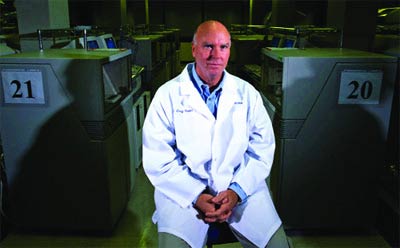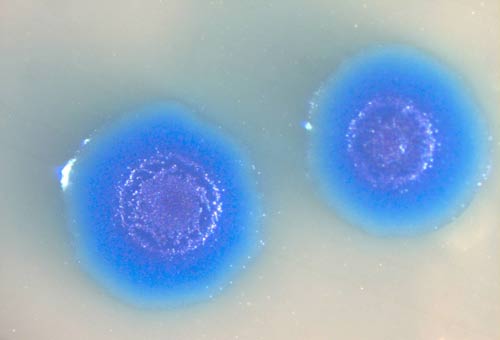Can create life!
DNA is like a guide to biological life. Each species has a unique set of instructions, ie genes. Scientists have long questioned: If they switch these indicators, can they transform one organism into another?
In an important field of a very young field, designing life, scientists at the J. Craig Venter Institute in Rockville, Maryland (USA), specialize in only one work: exchanging genomes of different species. They succeeded in cultivating the entire genome of a bacterium into another species, transforming the gene-receiving species into a body that all senses see, feel . are similar to the genes for genes.
"This is equivalent to converting a Macintosh computer into a PC by inserting a new software," said Dr. J. Craig Venter. "Synthetic biology still has many things to prove, but now we are much closer to know that it is a workable theory. "
The prospect of artificial life
The fledgling synthetic biology field is based on the assumption that scientists can establish life from the lowest level upwards, that they can choose features that are capable of deciding what an organism will eat. What, where to grow and how quickly to regenerate.

Dr. J. Craig Venter from the Genetic Biology Research Institute named him in Rockville (Photo: SGTT)
Organisms that are "completely designed " by human hands can bring many applications in life. They can be used to create inexpensive biofuels from a variety of crops and biomass, including wooden materials that have become too expensive to earn today. They can help clean up chemical spills, oil spills and many other human-caused environmental disasters.
But there is still a question: Can DNA alone make a creature, or must there be other factors? The study, published in the journal Science, seems to have answered this question, at least for simple bacteria like mycoplasma.

DNA from mycoplasma mycoides is implanted in proximal bacteria, mycoplasma capricolum, to produce artificial mycoplasma mycoides.(Photo: fizteh.ru)
"Just considering the chromosome set, without any extra proteins, is enough for the formation of this cell system," Dr. Venter said. "That's a very important finding for the future of the field." this study. It really simplifies the work '.
Any repair to nature causes questions about morality, not about safety concerns. But in this case, scientists do not create a new real agency, Dr. Venter said. The genome already exists and the resulting organism is exactly the same as that found in nature. What's new is the process of creating that organism. And when scientists take the next step and proceed to design organisms completely from zero, questions about safety and moral issues will be raised.

Led by microbiologist John Glass, researchers at J. Craig Venter Institute only specialize in the transcription of genomes of different species (Photo: SGTT)
The value of bacteria
Led by microbiologist John Glass, researchers at J. Craig Venter Institute took DNA from mycoplasma mycoides, a small bacterium found in the goat's gut, and brought it into the body of a strain of bacteria. close relatives, mycoplasma capricolum. One in 150,000 times like that had results. Mycoplasmas has a small number of genes - about 500 - and no cell walls, so it is easier to put foreign DNA into it. Bacterial simplicity also makes it a good environment to begin to determine the minimum level of genome needed to create life, an important step in future efforts to design life from lowest level or more.
While other researchers welcomed this technical achievement, they wondered about the benefits of a constructive approach from scratch."When looking for ways to design a useful organism, the cost is a number one concern , " said George Church, a professor of genetics at Harvard Medical School. "And starting from zero is the most expensive approach."
Stephen del Cardayre, vice president of research and development at LS9 Company in San Carlos, California, said: "When trying to create creatures that can make biofuels more efficient - like is turning wood materials into alcohol-like or gasoline-like compounds - nature has provided many starting points, such as E. coli. " According to him, the study authors need to prove that this is cheaper or faster, or a benefit. And this work has not shown that.

Creating life from the cell level in the laboratory is a vision of synthetic biology.(Photo: SGTT)
Creating life from the cell level in the laboratory is a vision of synthetic biology
Research is an important academic achievement, but it is not really important for the transition from fossil fuels to renewable biofuels. Biofuels also face some difficulties. The most obvious difficulty is that they must compete on price with petrochemical products. To solve this, researchers are looking for microorganisms that can transform biomass into fuel more efficiently than current processes.
With a few modifications, existing organisms can be designed to achieve these goals, Dr. Del Cardayre said. He also said that LS9 company will publish its 'renewable oil' project from a genetically modified organism for about a year. He said: 'I don't need a synthetic creature to do that.'
Thu Lan
For decades, scientists have known that bacteria are not like plants and animals, because they lack a defined cell nucleus that can freely exchange genes.And Dolly, a sheep born cloned in 1996, has shown that a cell nucleus taken from a cell and implanted into a cell eliminates another nucleus, which can develop into a living animal.But scientists have never taken the single DNA of a species, have no auxiliary proteins, and successfully placed it on another species and transformed it in the process.
- Video: How to create fire from lemon extremely unique
- 18 secrets to long life
- Form of artificial life
- Create synthetic diamonds that help find life on another planet
- Unexpected moments create a beautiful picture
- Find the chemical compound that makes life on Earth
- Billionaires are offered an immortal life
- How to create motivation for success
- Testosterone and female sex life
- Women love much old quickly?
- The prospect of extending life for 40 years for humans
- Google Earth will evolve into ... Second Life
 Why do potatoes have eyes?
Why do potatoes have eyes? 'Tragedy' the world's largest carnivorous life: Death becomes ... public toilet
'Tragedy' the world's largest carnivorous life: Death becomes ... public toilet Tomatoes were once considered 'poisonous' for 200 years
Tomatoes were once considered 'poisonous' for 200 years Detecting microscopic parasites on human face
Detecting microscopic parasites on human face